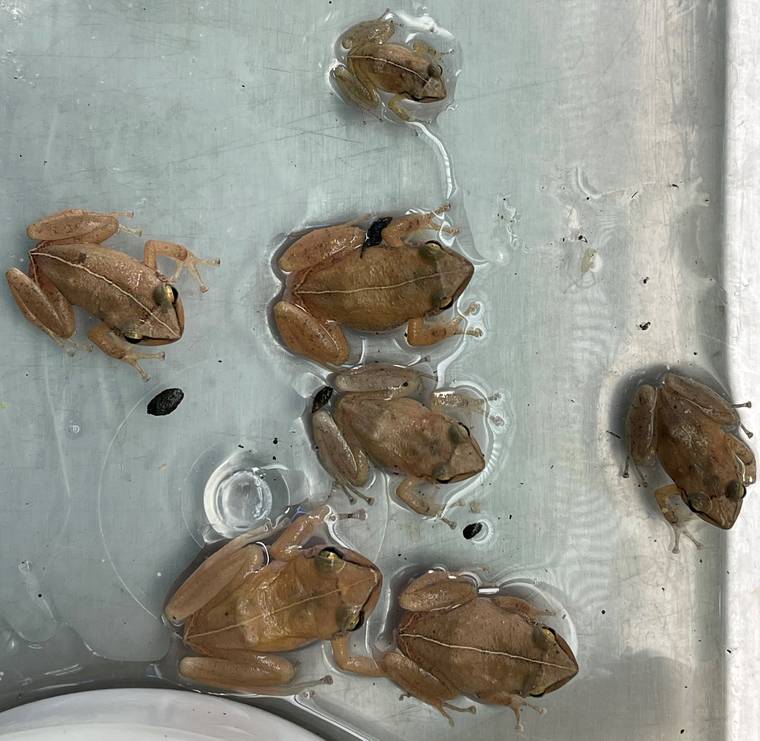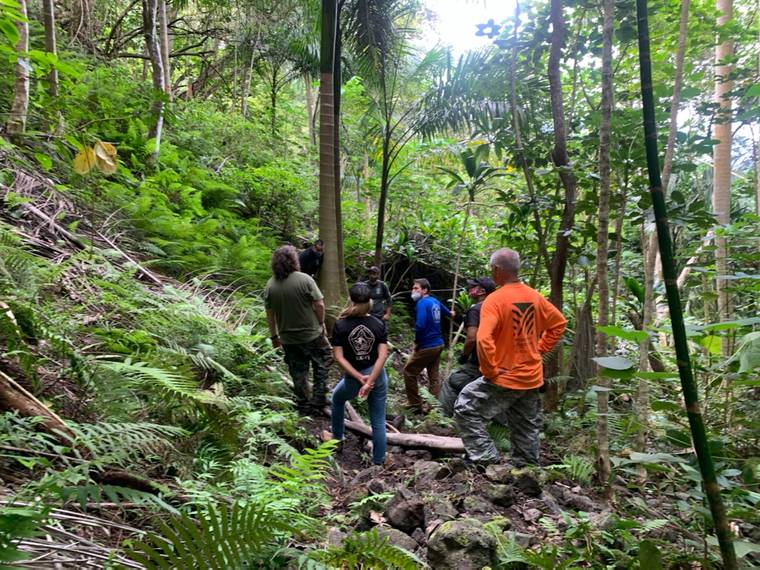Invasive coqui frogs found in Waimanalo trigger eradication campaign

COURTESY DLNR
Coqui frogs caught in Waimanalo.

COURTESY DLNR
People search for coqui frogs in a remote area in Waimanalo.


An infestation of coqui frogs, the Caribbean species famous for their piercing, sustained nocturnal calls, has been uncovered in a remote area of Waimanalo by the Hawaii Department of Agriculture, triggering a multi-agency eradication campaign, the state Department of Land and Natural Resources announced today.
The primary impact zone appears to be about an acre along the base of the mountains in Waimanalo where 65 of the brown frogs, which grow up to 2” long, have been hand captured thus far and an incident command structure has been established.
Eleutherodactylus coqui was first detected in the late 1980s on Hawaii Island where the frogs have become entrenched. A major noise nuisance, they pose a threat to native eco-systems, DLNR said, noting coqui compete with native birds to eat insects and spiders.
“Unfortunately, this coqui infestation is in a remote area and has gone undetected for some time despite HDOA staff responding to reports and conducting night monitoring for more than 10 years in Waimanalo,” said Phyllis Shimabukuro-Geiser, chairwoman of the Hawai`i Board of Agriculture, noting detection in remote areas is difficult as coqui are heard mainly at night.
“We continue to urge residents to report any suspected coqui infestations,” Shimabukuro-Geiser said, and thanked DLNR, Hawaii Invasive Species Council, Oahu Invasive Species Committee and the Department of Hawaiian Home Lands for their partnership “in this effort to contain and eradicate this coqui population.”
DLNR Chairwoman Suzanne Case said the coqui is a top priority species for the Oahu Invasive Species Committee, along with miconia, a fast-growing weedy tree, and the little fire ant.
Don't miss out on what's happening!
Stay in touch with breaking news, as it happens, conveniently in your email inbox. It's FREE!
DLNR “will be working closely with HDOA to do everything we can to contain this critical threat,” Case said.
A Waimanalo resident reported hearing coqui frogs in the area in early February, but no frogs were heard or captured that night by HDOA Plant Quarantine Branch inspectors, the announcement said.
Afterwards, HDOA inspectors returned to the area five times, each time capturing 1-3 frogs, and, after hearing coqui frogs in the distance, obtained approval to search surrounding properties under the jurisdiction of the Honolulu Board of Water Supply, DLNR, and DHHL.
In March, a team of inspectors captured 33 coqui frogs.
Thus far this month, inspectors removed another 18 coqui frogs April 9 and an interagency crew has surveyed and mapped out the vegetation and terrain; on Thursday, 14 more frogs were apprehended.
The immediate concern is to prevent the frogs from spreading to other areas, the announcement said, noting the Plant Quarantine Branch will be conducting routine night searches to remove frogs and prevent their invading adjacent areas by making the habitat inhospitable to them and surrounding the infested area with a buffer zone.
The branch works with landowners to eradicate coqui and also works with shippers to keep cargo from infested areas free of coqui through inspections and treatment.
Also on Oahu, in June 2003, a coqui infestation was detected and successfully eradicated after three years using citric acid in a 9-acre forested area in Wahiawa including part of the U.S. Army’s East Range.
Anyone hearing coqui frogs on Oahu, Kauai and in Maui County should contact the state’s toll-free pest hotline at 643-PEST (7378).
For photos, coqui prevention tips and to hear the cry of a coqui, go to hear.org/AlienSpeciesInHawaii/species/frogs Opens in a new tab




